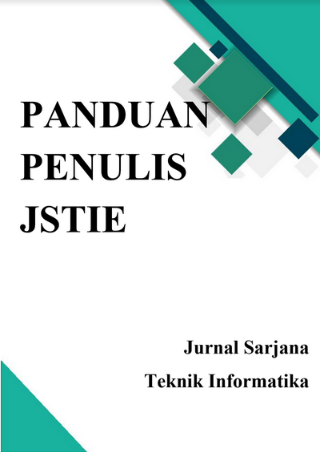PEMBUATAN MODEL RENCANA STRATEGIS SI/TI (STUDI KASUS: DEPARTEMEN AKADEMIK UNIVERSITAS XYZ)
DOI:
https://doi.org/10.12928/jstie.v2i1.2621Abstract
Departemen Akademik merupakan Departemen Akademik yang bertugas membantu dan memperlancar jalannya proses bisnis sebuah universitas. Tugas utama Departemen Akademik adalah memberikan layanan administrasi dan informasi akademik secara bertanggung jawab, tepat, cepat, akurat dan ramah. Untuk melaksanakan tugasnya, Departemen Akademik membangun suatu sistem informasi yang dapat menunjang lancarnya tugas pokok dari Departemen Akademik. Namun survey awal yang dilakukan, Departemen Akademik memiliki kendala dalam mengelola layanan akademik. Agar sistem informasi yang dikembangkan dapat mengatasi kendala yang ada dan sesuai dengan visi, misi, dan tujuan organisasi maka dibangun perencanaan strategis di Departemen Akademik yang berfokus pada pembuatan model rencana strategis SI/TI, dengan menggunakan Tahap penelitian The Planning Process by Anita Cassidy.
Pembuatan model rencana strategis SI/TI digunakan untuk mendukung strategi bisnis organisasi agar mampu mencapai tujuan bisnisnya dengan lebih cepat. Kemampuan tersebut terkait langsung dengan bagaimana organisasi memilih strategi, aplikasi dan kebijakan organisasi yang tepat dengan berfokus pada pembuatan model rencana strategis SI/TI yang terdiri dari empat tahap Planning Process, yang terdiri tahap visi (The Visioning Phase), tahap analisis (The Analysis Phase), tahap arah (The Direction Phase), and tahap rekomendasi (The Recommendation phase). Dan melakukan uji kelayakan model rencana strategis SI/TI yang meliputi pengembangan Road Map yang dirancang.
Penelitian ini menghasilkan sebuah pemodelan berbasis usulan rencana strategi SI/TI. Hasil pengujian sistem yang telah dilakukan menyatakan model yang dibuat layak diterapkan di Departemen Akademik sebagai perpanjangan tangan dari Universitas XYZ.
Kata kunci: Departemen Akademik, Rencana Strategis, SI/TI, Road Map.
References
Surendro, Kridanto. 2009. Pengembangan Rencana Induk Sistem Informasi.Informatika.
White, S. A., (2003). Business Process Modelling Notation, http:/www.bpmi.org
Cassidy, Anita. 2006. Information System Strategic Planning. Auerbach Publications, Taylor & Francis Group.
Alexander Osterwalder, Yves Pigneur, Christopher L. Tucci., (2005). Clarifying Busines Model: Origins, Present, and Future of the Concept Communications of AIS Volume 15.
John Ward, Joe Peppard., (2002). Strategic Planning for Information System John Wiley and Sons, LTD. Cranfield School of Management, Cranfield, Bedfordshire, United Kingdom.
Ayu Yulianingsih, Dyah. (2011). Pembuatan EAP Teknologi Informasi Layanan Akademik Menggunakan Zachman Framework (Studi Kasus: Universitas XYZ). Yogyakarta: Universitas Ahmad Dahlan.
Aulia, Nur. (2011). Tata Kelola TI Universitas XYZ. Yogyakarta: Universitas Ahmad Dahlan.
Mafatihus Sholihah, Husniati. (2011). Perencanaan Sistem Informasi fakultas Teknologi Industri UAD berbasis Enterprise Architecture Planning. Yogyakarta: Universitas Ahmad Dahlan.
Prof. Dr. Jogiyanto HM, MBA, Akt (2011). Sistem Informasi Strategik. Yogyakarta: Penerbit ANDI
http://wijasena.wordpress.com/2011/12/20/sekilas-tentang-disasterrecovery center-drc/
www.baa.uad.ac.id
http:/elib.unikom.ac.id/files/disk1/382/jbptunikompp-gdl-damartarad-19057-5-babii.pdf, 15 November 2011
Pengertian Sistem Informasi, http://www.nicdesain.net/getfile.php?id=4, 15 November 2011
Kadir, Abdul. 2002. Pengembangan Sistem Informasi. Yogyakarta: Penerbit ANDI
Downloads
Published
Issue
Section
License
License and Copyright Agreement
In submitting the manuscript to the journal, the authors certify that:
- They are authorized by their co-authors to enter into these arrangements.
- The work described has not been formally published before, except in the form of an abstract or as part of a published lecture, review, thesis, or overlay journal. Please also carefully read Journal Posting Your Article Policy.
- The work is not under consideration for publication elsewhere.
- The work has been approved by all the author(s) and by the responsible authorities – tacitly or explicitly – of the institutes where the work has been carried out.
- They secure the right to reproduce any material that has already been published or copyrighted elsewhere.
- They agree to the following license and copyright agreement.
Copyright
Authors who publish with Jurnal Sarjana Teknik Informatika agree to the following terms:
- Authors retain copyright and grant the journal right of first publication with the work simultaneously licensed under a Creative Commons Attribution License (CC BY-SA 4.0) that allows others to share the work with an acknowledgement of the work's authorship and initial publication in this journal.
- Authors are able to enter into separate, additional contractual arrangements for the non-exclusive distribution of the journal's published version of the work (e.g., post it to an institutional repository or publish it in a book), with an acknowledgement of its initial publication in this journal.
- Authors are permitted and encouraged to post their work online (e.g., in institutional repositories or on their website) prior to and during the submission process, as it can lead to productive exchanges, as well as earlier and greater citation of published work.







